|
Getting your Trinity Audio player ready...
|
If you think fake news is bad, you’re going to be sick when you really start to dig into history.
Let’s start with a story most people know about. Until the last decade or so, Richard Nixon was the most controversial President in modern American history due to the Watergate scandal and everything surrounding it.
But what if everything we thought we knew about Watergate is wrong? Richard Nixon, despite being re-elected in one of the largest landslides in U.S. history, was swiftly dismantled, but not for crimes of war or corruption. Instead, he was taken down for a third-rate burglary he may not have even known about. Is it possible the real scandal wasn’t what Nixon did, but who wanted him gone? Bob Woodward, one half of the duo credited with exposing the affair, was a former naval intelligence officer with curious access and connections, including ties to the Pentagon and possibly the Central Intelligence Agency (CIA). Some researchers have suggested he may have been more than just a reporter with a nose for news. And what of the whispers that elements of the CIA or other federal agencies had motivations to oust Nixon, whose independence and moves toward détente may have threatened deep state interests? Nixon stated more than once, in his recordings, that he assumed Federal Bureau of Investigation (FBI) Deputy Director Director Mark Felt was working to oust him, for example.
When you line this up against decades of genuinely criminal activity that Washington has quietly buried, you have to ask: was Nixon’s fall a morality play, or was it a meticulously engineered takedown of an inconvenient maverick?
We may never know.
So, I will recount a history with quite a bit less at stake, and one that I have dug into recently due to the work of legendary Jiu-Jitsu competitor Robert Drysdale, who has spent the last five years digging up the buried history of Brazilian Jiu-Jitsu. Which he published in his book Opening Closed‑Guard: The Origins of Jiu‑Jitsu in Brazil.
If you have ever trained at a Jiu-Jitsu academy in the Western Hemisphere, you have likely heard the basic history of how Jiu-Jitsu made its way from Japan to Brazil and to the USA.
In the late 1800s, Jigoro Kano revolutionized Japanese martial arts by creating Judo: an art rooted in traditional jiu-jitsu but distilled for effectiveness, efficiency, and the principle of “maximum efficiency with minimum effort.” One of his top students, Mitsuyo Maeda, became a global ambassador for the art. In 1914, Maeda arrived in Brazil, where he formed a friendship with Gastão Gracie. As a gesture of gratitude, Maeda took Gastão’s young son, Carlos Gracie, under his wing, teaching him the fundamentals of his fighting system.
Carlos Gracie trained diligently and eventually began teaching the art himself, refining the techniques with his brothers—most notably Helio Gracie—who, due to his smaller frame and health limitations, adapted the techniques further to rely on leverage and timing rather than brute strength. This evolution became known as Gracie Jiu-Jitsu: a uniquely Brazilian interpretation of Kano’s original teachings, optimized for real-world self-defense. Over the decades, the Gracie family rigorously tested their style in challenge matches across Brazil and later the U.S., proving its supremacy against boxers, wrestlers, and other martial artists.
The culmination of their efforts came in 1993 with the founding of the Ultimate Fighting Championship (UFC), where Royce Gracie, representing the family, dominated much larger opponents using pure jiu-jitsu. This moment marked the global awakening to the effectiveness of Gracie Jiu-Jitsu, and forever changed the landscape of martial arts, all thanks to Grandmaster Carlos and his brother, Helio.
Great story! Except it’s probably not true.
According to Drysdale, before the name Gracie became synonymous with Brazilian Jiu-Jitsu, the art had already taken root in Brazil through a cast of overlooked pioneers. Mitsuyo Maeda arrived in Belém and passed his knowledge not just to the eager Carlos Gracie, but more immediately to local athletes like Jacyntho Ferro: a wrestler who quietly became one of Brazil’s first true students of Jiu-Jitsu. Donato Pires dos Reis, a verified Maeda disciple, opened the first official Jiu-Jitsu academy in Rio and gave Carlos Gracie his start as an assistant instructor, only to be later erased from the record after a falling out.
In São Paulo, Geo Omori was staging public matches and running his own academy well before the Gracies appeared on the scene. And why wouldn’t he? Brazil had a significant Japanese immigrant population that would have carried the martial arts with them.
Amid this vibrant, contested, multicultural stew of martial development, Carlos Gracie managed something far more enduring than victory in the ring: he branded a myth.
By simplifying the story, framing himself as Maeda’s direct protégé and his family as the sole stewards of the art, he created a lineage as sleek as it was selective. The others, some of them better fighters and more established instructors, quietly faded into the footnotes. They were written out not because they lost but because they didn’t own the pen, they didn’t etch their story in stone, and they didn’t control the history they made.
It’s a tale less of deceit and more of historical convenience, where the founders of the art were slowly turned into ghosts, and a single surname became the banner under which a much more complex story was flattened and sold to the world.
Is this a Bitcoin article, Kurt?
Haha! Of course, it is. You see, every subculture has a story full of half-truths. My focuses in life have been Bitcoin, BJJ, and the Christian Church, so you can be glad this article isn’t about why the Pope isn’t actually the rightful Bishop of Rome! But while I am often called out as something of a conspiracy theorist in the Bitcoin space, I decided I would preface my thoughts with some really inconvenient, contentious history of Jiu-Jitsu as a backdrop, so the Jiu-Jitsu hierarchy can hate me over there too.
In the Bitcoin world, there is a very real problem of provenance about who owns the name, who owns the code, who owns the protocol, who owns the database… There’s also a huge amount of nonsense about the history and mythos of Satoshi Nakamoto.
So, does anyone know the real history of Satoshi Nakamoto or Bitcoin?
We know that by 2014, critical infrastructure tied to the Satoshi alias (his email accounts, SourceForge repository access, and various online profiles) had been compromised. Some of these were used in extortion attempts, and others to post strange or suspicious content. But what’s less clear and more troubling is how early that compromise began. Amid the heated Bitcoin XT debates in 2015, a message posted from a Satoshi-linked account surfaced that read like poorly veiled propaganda for Bitcoin Core, advocating small blocks in a tone that clashed starkly with Satoshi’s prior writings. It didn’t sound like him at all. Was it a forgery? A hijacked account? A puppet of the Core devs? We simply don’t know.
That’s the real problem: we don’t know. Was his last commit on SourceForge actually his? Was his final year of forum posts really written by Satoshi, or was it written by someone who had already wormed their way into his credentials? Somewhere between 2010 and 2014, the real Satoshi disappeared, not just from public view but from the keys, accounts, and infrastructure that defined his presence in the Bitcoin project. The lack of clarity on this timeline has real implications for the legitimacy of development decisions, the centralization of narrative control, and the moral authority invoked by those claiming to act for “Satoshi’s vision.”
Without knowing when the mask was stolen, we can’t say for sure who anyone has been listening to ever since. And in its place, usurpers have created a massive meme of Satoshi remade in their own vision!
Furthermore, we have observed the power in the control of the Bitcoin and Satoshi narratives many times now. During the scaling battles of the Bitcoin Civil War, people bringing up Satoshi’s writings were deemed suspect for appealing to authority, while the small blocker faction pointed to the power of people to choose what version of bitcoin to run on their mom’s computer to the #UASF and #No2X portion of the war in 2017.
But then, claiming true succession from Satoshi’s code repo, they claimed simply that they were extending the Satoshi client and that they were honoring his vision by whatever it was that they were doing because Satoshi put Gavin in charge, and Gavin put Greg and his friends in charge, so if you agree on dynastic succession, Greg Maxwell was basically Satoshi! (eyes roll out of head)
So, a couple of lessons so far:
1. Logins and keys aren’t identity.
2. The Core Devs want you to think they are King Satoshi the 3rd.
3. History is only as reliable as the CIA agent who wrote it.
4. If you care about your legacy, get really good at marketing your gym (I think.)
But wait! Bitcoin fixes this!
Imagine if Bitcoin was in wide use for the last hundred years!
We might have stayed out of The Great War, World War 2, Vietnam, the War on Terror, and never had a President Ford (or a few others…) and whole industries and nations would be entirely different. But let’s not speculate too hard!
Today, we may not know definitively who Satoshi Nakamoto is, but I sure know we are not “ALL SATOSHI,” and we wouldn’t have to be subjected to yearly unveilings of this guy around the globe either if we were properly using attestation systems on Bitcoin!
While public key signing alone isn’t definitive proof of identity, it is a powerful building block in a broader framework of verifiable attestation. When combined with a robust identity protocol on a public blockchain— one that anchors credentials, behavior, and social context to immutable records—signatures become meaningful components of long-term trust. The result is a system where identity isn’t just, but earned and proven over time. In such a world, signing important messages or documents with a well-attested key could anchor reputational integrity to recorded history. Imagine a blockchain entry from 1929 with Carlos Gracie signing that he was enrolling as a student under Donato Pires dos Reis, years before the Gracie Academy banner was unfurled.
A single transaction could upend a century of mythmaking.
The integrity of historical records isn’t just about identity, but also resilience against tampering. By hashing business ledgers, social events, and public statements into a timestamped, proof-of-work-secured chain, we make retroactive falsification nearly impossible, and that changes the nature of trust and economics for everyone!
Lastly, garbage in still means garbage out, and critics of these ideas will often say that just because it’s on chain doesn’t mean it’s true. They’re right, so filtering matters.
Proof of work (PoW), properly implemented, serves as both a cost and a filter: it slows down spam, raises the stakes of fraud, and privileges the sincere. Imagine if each person had to record their economically or historically meaningful actions using their verified digital identity and back it up with sufficient PoW, on a device cryptographically linked to that identity. Bad news for Bob Woodward’s anonymous sources. Bad news for Helio Gracie’s post hoc origin story. Maybe even bad news for Pope Leo XIV! But good news for Satoshi Nakamoto and for anyone who believes that truth deserves to outlive the agenda of whoever holds the pen when history is being written.
Watch: History of Bitcoin with Kurt Wuckert Jr.

 08-21-2025
08-21-2025 





